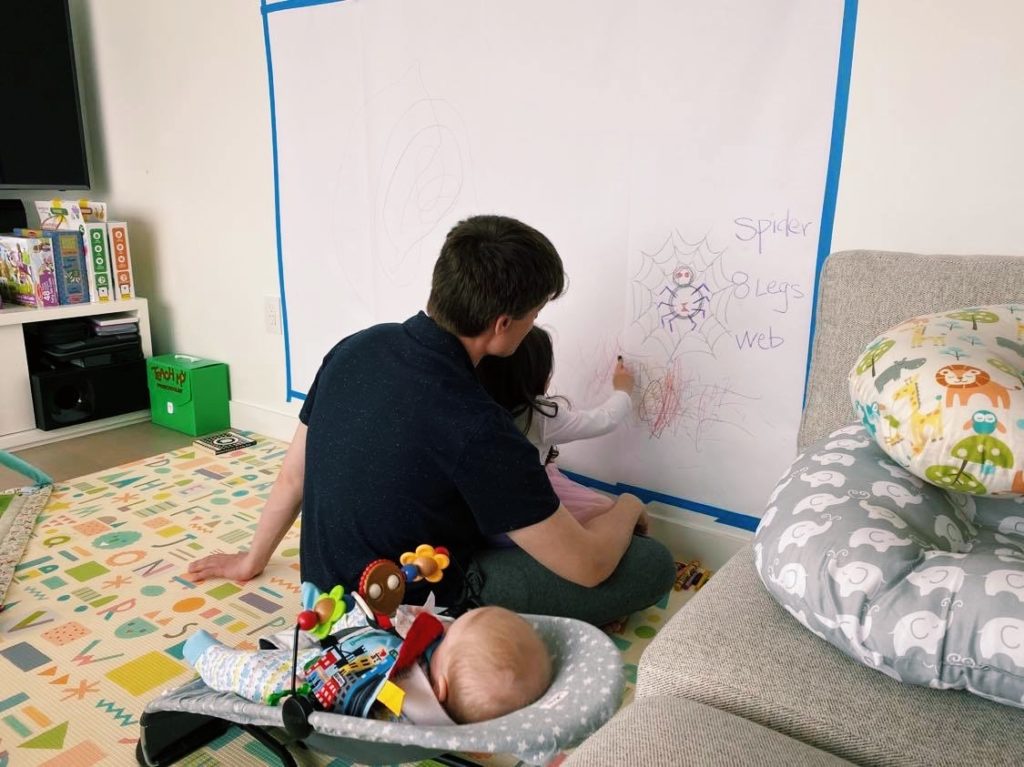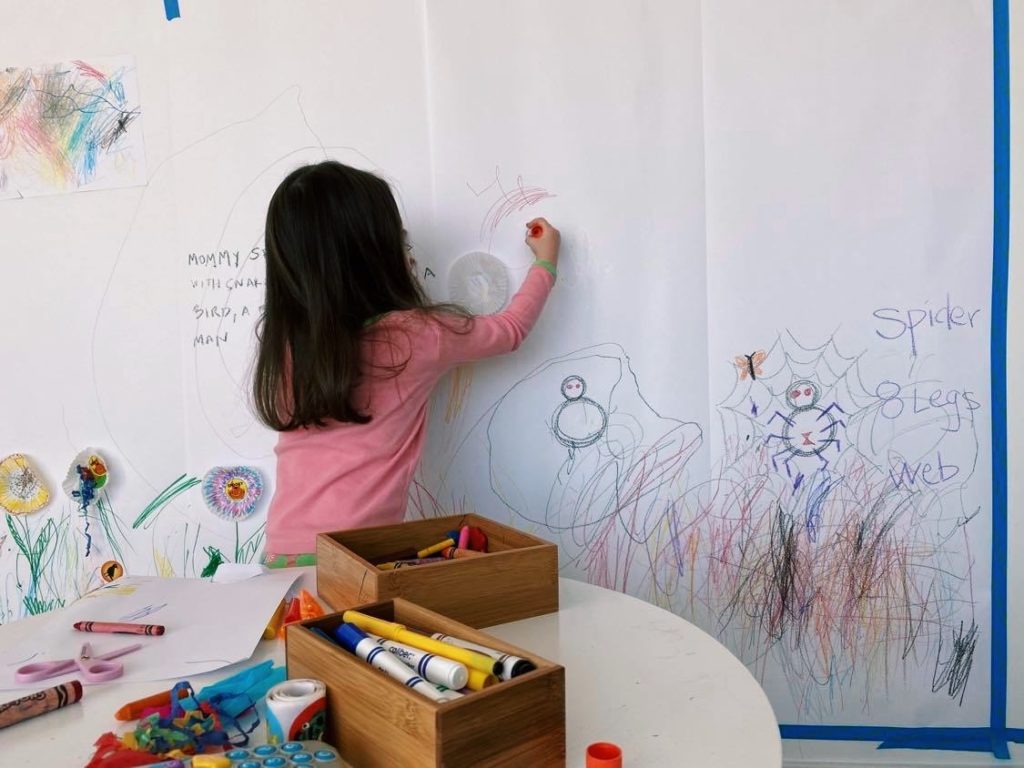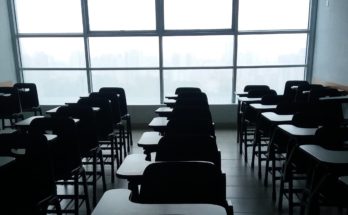Emily Anderson, an entrepreneur in Queens, has spent the past month adjusting to the new reality of having her kids at home, including a 5-month-old baby. “It’s just been such an evolving roller coaster of emotion,” she said.
To contain the novel coronavirus, over 1 million students in New York City made the switch to remote learning in March. Educators are adapting quickly, but in order to ensure a smooth transition, they need the help of parents, many of whom have no background in teaching. The situation is most dire for low-income families with limited English, education levels or internet access.
Still, for families like the Andersons, the task is made difficult by the added responsibility of caring for infants. Lives changed overnight; moms who were already anxious to juggle work and parenting babies suddenly had their older children to watch and, sometimes, teach.

When her daughter’s preschool, New York Kids Club in Long Island City, transferred to online only, Anderson was disappointed but expected the announcement. “Everything changed so fast within the course of just a couple days,” she said. “Our school held out as long as they could.”
She described the subsequent week as “pure survival mode.”
Fortunately, as the founder of a community network called Mom Crew, Anderson could do her job from home. “We are able to watch our kids, even though it means not getting done what we want to do for our businesses and our careers,” she said.
Under more usual circumstances, New York Kids Club supervises her three-year-old for the full workday, leaving Anderson more time to focus on her baby and business. Once remote, the preschool’s hours became 9 a.m. to noon, with talks of shortening the day further.
At the start of online learning, the Andersons gathered around the table first thing each morning to log into Zoom, where their daughter could see her classmates. They tried to help her focus for the duration of the school day, but the preschooler’s interest in a two-dimensional screen was fleeting. “One of us really needs to sit there with her,” said Anderson. “There’s absolutely no way she would sit there herself.”
Soon, Anderson decided to scale back. “I think we got a little too ambitious with trying to do all of the virtual schedule,” she said. “Some days, it’s just really not working.”
When that happens, the Andersons come up with their own lesson plans, using their “makeshift chalkboard”: white paper taped to the wall. “That’s become our own little classroom,” she said, for learning about insects, flowers, and the alphabet. They also do art projects, play dress-up, run or scooter in the hall, and take a children’s yoga class on Amazon Prime. “My daughter is only about half into it,” Anderson conceded. “I think my husband and I are enjoying it more.”

Meanwhile, the Andersons still have to find time to attend to the baby — to put him down for naps and to feed him; to work with him on his motor skills, read stories, and play on his mat. “It’s a lot to balance,” said Anderson. “That’s really the hardest part.”
On the other hand, her children’s young ages have their advantages. “The upside is we aren’t tied to any particular learning schedule,” she said. “Parents of school-aged kids, they have to keep up with virtual learning so their kid doesn’t fall behind, whereas if we don’t learn the letter ‘B’ this week, we’re probably okay.”
The Toutounases are one of many families that have to keep pace with their kids’ curricula. On weekdays, Lili Toutounas helps her 8-year-old son with his schoolwork. “It’s a lot of hand-holding,” she said. Meanwhile, she also has to make time for her daughter, who is 10 months old. Only then can she momentarily focus on her full-time job or herself.
“I think what’s ominous is like, this is the third week,” said Toutounas, “and knowing that it’s going to continue for a while.”
When Toutounas first told her son that P.S. 150 in Sunnyside, Queens, was closing, his reaction was typical school-aged boy. “He was like yay, no school,” she said. “I think he didn’t really know what it meant. It wasn’t until I said other activities will also be closed, like Cub Scouts, that he was like, oh.” Registering the gravity of the situation, his excitement dulled.
In an instant, both children’s schedules became wide open. With classes on pause, Toutounas and her partner are trying to home-school and enlist their son’s help with chores, like cooking or emptying the dishwasher. They also assumed full-time care for their daughter, who usually has a babysitter during work hours. They took her to the swings while parks were still open, but the rest of the day was unstructured.
Then remote learning began for their son, including assignments on Google Classroom and biweekly class meetings on Zoom, a video conference service. However, much of the burden continued to fall on parents. “It’s a lot of sitting with him, helping with math assignments and other things like that,” said Toutounas. “He’s gotten more technologically savvy, but Google Classroom is a little bit weird.”
At the same time, the Toutounases also try to split their time with the baby, who they aim to take outside once or twice a day. “I worry that we’re not giving her enough stimulation because we can’t do everything,” she said. “It’s hard to give them both 100 percent.”
For the Comnenoses in Brooklyn, the transition to life in quarantine felt insurmountable at first. “I think we were in shock,” said Pallas Comnenos, the family’s matriarch. “The first week was extremely, excruciatingly slow. It felt like one long day, with a couple of naps in there.”
The Comnenos’ oldest is a fourth grader at A. Fantis School, a parochial school affiliated with the Saints Constantine and Helen Greek Orthodox Church in Brooklyn Heights. Her younger sister was one year old, enrolled in Imagine Early Learning Center in Dumbo, when COVID-19 turned New York upside down.
Classes at A. Fantis moved online in March. “I didn’t connect the dots, but it was Friday the 13th,” said Comnenos. Imagine Dumbo also closed, but without a remote alternative. “I think with that age group, it’s just impossible,” she said. Previously, her toddler spent from 9 a.m. to 6 p.m. at the daycare center.
But the distress they felt when they first went into lockdown has since diminished to a dull ache. For this, Comnenos credits her older daughter’s teacher, whose organization and dedication to her students added structure to their days. “We’ve gotten into this routine, so this week went a bit faster,” she said, “but it was still rather painful.”
Their routine is as follows: before classes begin at 8:15 a.m., the family of four often congregates in the living room in their Dumbo apartment. Comnenos and her husband start the workday, and their older daughter logs onto Zoom. Much of her school schedule has remained the same, just relocated online. The teacher holds class for 13 students until 2:15 p.m., with a couple breaks throughout the day. Then they complete homework, which has increased in recent weeks. “It’s good they have a lot of homework,” her mom said. “They need things to keep them busy.”
As much as the Comnenoses enjoy each other’s company, their rationale for sharing a room is more practical: the Wi-Fi is too weak in the other rooms to spread out.
But the living room is also the younger daughter’s play space, with all her toys scattered about. Although the toddler can entertain herself for a while, eventually, one of her parents has to take a break from work to feed or play with her. Comenos even tried a reading group with other moms from Imagine Dumbo over video-chat, but she said, “Their attention span was like five minutes and then they wandered off, so we dropped that.”
“We’re just trying to stay positive that, hey, we’re all here together,” said Comnenos. “But the daily tasks are difficult with all of us at the same time, in the same house, sometimes in the same room.”
And close quarantine quarters still take some getting used to. “On a regular day, you go to the office, the kids are off to their own environments, and then you all come back together again,” said Comnenos. But now, she explained, “there’s none of that” — their worlds shrunk to fit inside their Brooklyn apartment.




“Their worlds shrunk to fit inside their Brooklyn apartment.” You have such a way with words Ms. Bamberger! Please keep it up. You are a true joy to read.